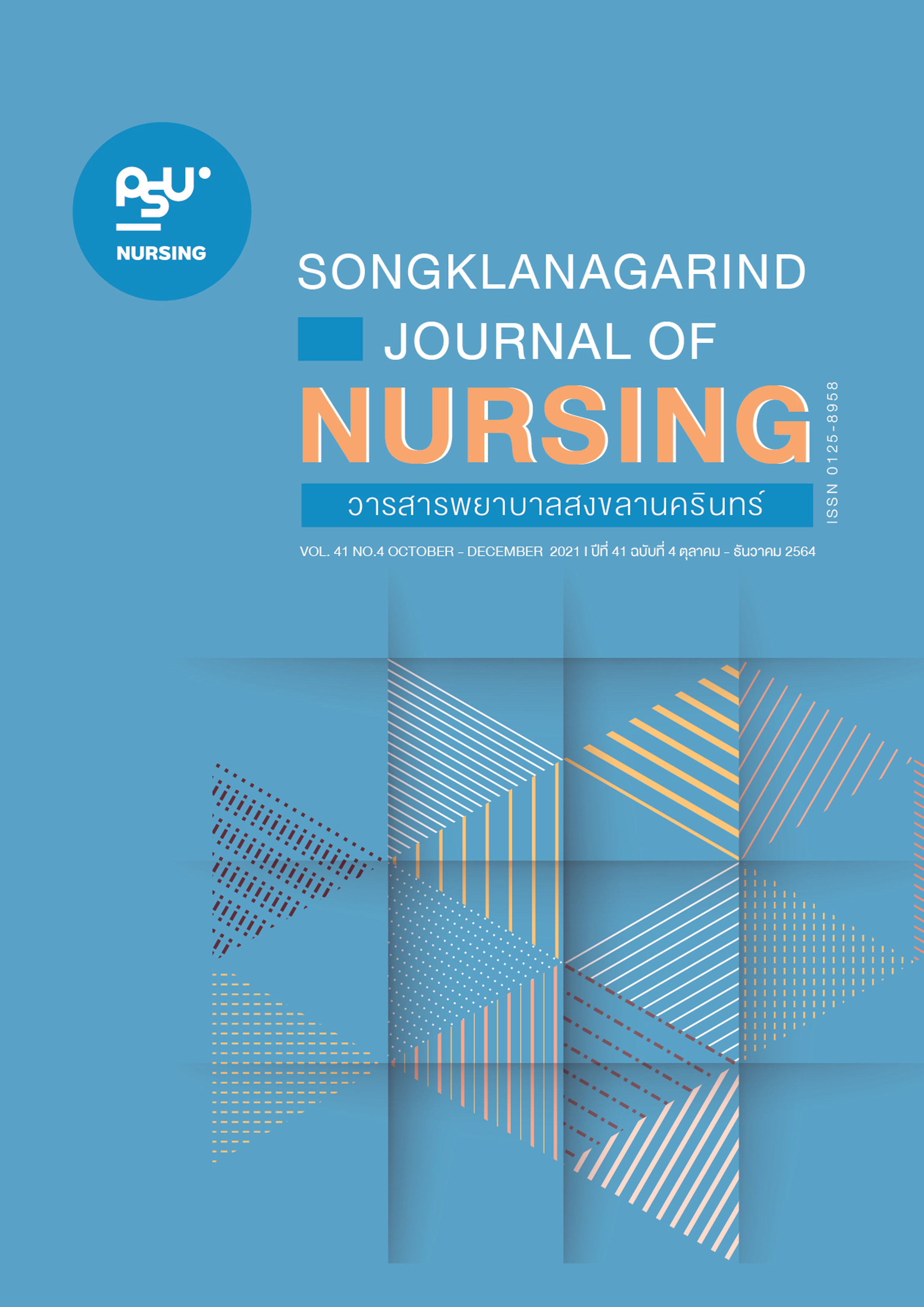Nurse’s Role in Promoting Exercise Self-Efficacy for Heart Failure with Reduced Ejection Fraction Patients: A Case Study
Main Article Content
Abstract
Introduction: Exercise is important for cardiac rehabilitation in heart failure (HF) particularly among people with ejection fraction less than 40% due to its effects on reducing fatigue from HF pathology and increasing functional capacity. Consequently, hospital re-admissions and mortality rates decline. However, it is evident that many people with HF do not exercise regularly resulting from physical limitations and illness severity causing shortness of breathing. Low perceived exercise self-efficacy was found to be associated with nonadherence to exercise recommendation among HF patients. This article aims to demonstrate roles of exercise, Bandura’s self-efficacy theory, nurse’s roles, and an application of exercise self-efficacy promotion program in a case study of patient with reduced ejection fraction HF (HFrEF) including four components which are 1) mastery experience 2) vicarious experience 3) verbal persuasion and 4) emotional arousal. Conclusions: promoting exercise adherence is pivotal among people with HFrEF. Nurses are suggested to promote exercise self-efficacy and exercise adherence using self-efficacy theory among these patients.
Article Details
References
Jackson SL, Tong X, King RJ, et al. National burden of heart failure events in the United States, 2006 to
Circ Heart Fail. 2018; 11(12): 1-22. doi: 10.1161/CIRCHEARTFAILURE.117.004873.
Ariyachaipanich A, Krittayaphong R, Kunjara Na Ayudhya R, et al. Heart failure council of Thailand (HFCT) 2019 heart failure guideline: Introduction and diagnosis. J Med Assoc Thai. 2019; 102(2): 231-9.
Ponikowski P, Voors AA, Anker SD, et al. 2016 ESC Guidelines for the diagnosis and treatment of acute and
chronic heart failure. Eur Heart J. 2016; 37(27): 2129-200. doi: 10.1093/eurheartj/ehw128.
Apiromrat R. Promotion of quality of life among patients with congestive heart failure. Thai J Cardiothorac Nurs. 2017; 28(2): 2-15. Thai.
American Heart Association. Cardiac rehab for heart failure [Internet]. Dallas: American Heart Association; 2017 [cited 2020 Dec 10]. Available from: https://www.heart.org/en/health-topics/heart-failure/treatment-options-for-heartfailure/cardiac-rehab-for-heart-failure.
Klompstra L, Jaarsma T, Stromberg A. Physical activity in patients with heart failure: Barriers and motivations with special focus on sex differences. Patient Prefer Adherence. 2015; 9: 1603-10. doi: 10.2147/PPA.S90942.
Del Buono MG, Arena R, Borlaug BA, et al. Exercise intolerance in patients with heart failure: JACC State-ofthe-art review. J Am Coll Cardiol. 2019; 73(17): 2209-25. doi: 10.1016/j.jacc.2019.01.072.
Cooper LB, Mentz RJ, Sun JL, et al. Psychosocial factors, exercise adherence, and outcomes in heart failure patients: Insights from HF-ACTION. Circ Heart Fail. 2015; 8(6): 1044-51. doi: 10.1161/CIRCHEARTFAILURE.115.002327.
Waring T, Gross K, Soucier R, et al. Measured physical activity and 30-day rehospitalization in heart failure patients. J Cardiopulm Rehabil Prev. 2017; 37(2): 124-9. doi: 10.1097/HCR.0000000000000204.
Kankratoke P, Ruaisungnoen W. Home-base exercise cardiac rehabilitation program applying self-efficacy theory improved perceived exercise self-efficacy, exercise behavior and functional capacity among patients with reduced ejection fraction heart failure [master’s thesis].[Khon Kaen]: Khon Kaen University; 2021. 153 p. Thai.
Witwaranukool P, Jitpanya C. The effect of self-efficacy and outcome-expectancy promoting program on functional capacity in congestive heart failure patients. Thai J. Cardio-Thorac Nurs. 2009; 20(2): 17-30. Thai.
American Association of Cardiovascular and Pulmonary Rehabilitation [AACVPR]. Guidelines for cardiac rehabilitation programs. 6 th ed. Champaign, IL: Human Kinetics; 2020.
Pelliccia A, Sharma S, Gati S, et al. 2020 ESC Guidelines on sports cardiology and exercise in patients with
cardiovascular disease. Eur Heart J. 2021; 42(1): 17-96. doi: 10.1093/eurheartj/ehaa605.
American College of Sports Medicine. Guidelines for exercise testing and prescription. 7 th ed. Philadelphia:
Lippincott Williams & Wilkins; 2006.
Zwisler AD, Norton RJ, Dean SG, et al. Home-based cardiac rehabilitation for people with heart failure:
A systematic review and meta-analysis. Int J Cardiol. 2016; 221: 963-9. doi: 10.1016/j.ijcard.2016.06.207.
Piepoli MF, Conraads V, Corra U, et al. Exercise training in heart failure: From theory to practice. A consensus document of the Heart Failure Association and the European Association for Cardiovascular Prevention and Rehabilitation. Eur J Heart Fail. 2011; 13(4): 347-57. doi: 10.1093/eurjhf/hfr017.
Niebauer J, Mayr K, Harpf H, et al. Long-term effects of outpatient cardiac rehabilitation in Austria: A nationwide registry. Wien Klin Wochenschr. 2014; 126(5-6): 148-55. doi: 10.1007/s00508-014-0527-3.
Pearson MJ, Smart NA. Exercise therapy and autonomic function in heart failure patients: a systematic review and meta-analysis. Heart Fail Rev. 2018; 23(1): 91-108. doi: 10.1007/s10741-017-9662-z.
Snoek JA, Eijsvogels TMH, Van ’t Hof AWJ, et al. Impact of a graded exercise program on V-O2peak and survival in heart failure patients. Med Sci Sports Exerc. 2018; 50(11): 2185-91. doi: 10.1249/MSS.0000000000001688.
Conraads VM, Deaton C, Piotrowicz E, et al. Adherence of heart failure patients to exercise: barriers and possible solutions: a position statement of the study group on exercise training in heart failure of the heart failure association of the European Society of Cardiology. Eur J Heart Fail. 2012; 14(5): 451-8. doi: 10.1093/eurjhf/hfs048.
Rajati F, Sadeghi M, Feizi A, et al. Self-efficacy strategies to improve exercise in patients with heart failure: A
systematic review. ARYA Atheroscler. 2014; 10(6): 319-33.
Bandura A. Self-efficacy: Toward a unifying theory of behavioral change. Psychol Rev. 1977; 84(2): 191-215. doi: 10.1037//0033-295x.84.2.191.
Bandura A. Self-Efficacy: The exercise of control. New York: W.H. Freeman and Company; 1997.
Bandura A. Social foundations of thought and action: A social cognitive theory. Englewood Cliffs: Prentice-Hall; 1986.
Santiago de Araújo Pio C, Beckie TM, Varnfield M, et al. Promoting patient utilization of outpatient cardiac
rehabilitation: A joint International Council and Canadian Association of Cardiovascular Prevention and Rehabilitation position statement. Int J Cardiol. 2020; 298: 1-7. doi: 10.1016/j.ijcard.2019.06.064.
Supervia M, Medina-Inojosa JR, Yeung C, et al. Cardiac rehabilitation for women: A systematic review of barriers and solutions. Mayo Clin Proc. 2017; 13: 1-23. doi: 10.1016/j.mayocp.2017.01.002.
Pramthaisong S, Wanchi A, Ruaisungnoen W. Adherence promotion of exercise-based cardiac rehabilitation among patients with cardiovascular disease: A systematic review. Journal of Nursing Science & Health. 2018; 36(2): 222-33. Thai.
Imran HM, Baig M, Erqou S, et al. Home-based cardiac rehabilitation alone and hybrid with center-based cardiac rehabilitation in heart failure: A systematic review and metaanalysis. J Am Heart Assoc. 2019; 8(16): 1-11. doi: 10.1161/JAHA.119.012779.


